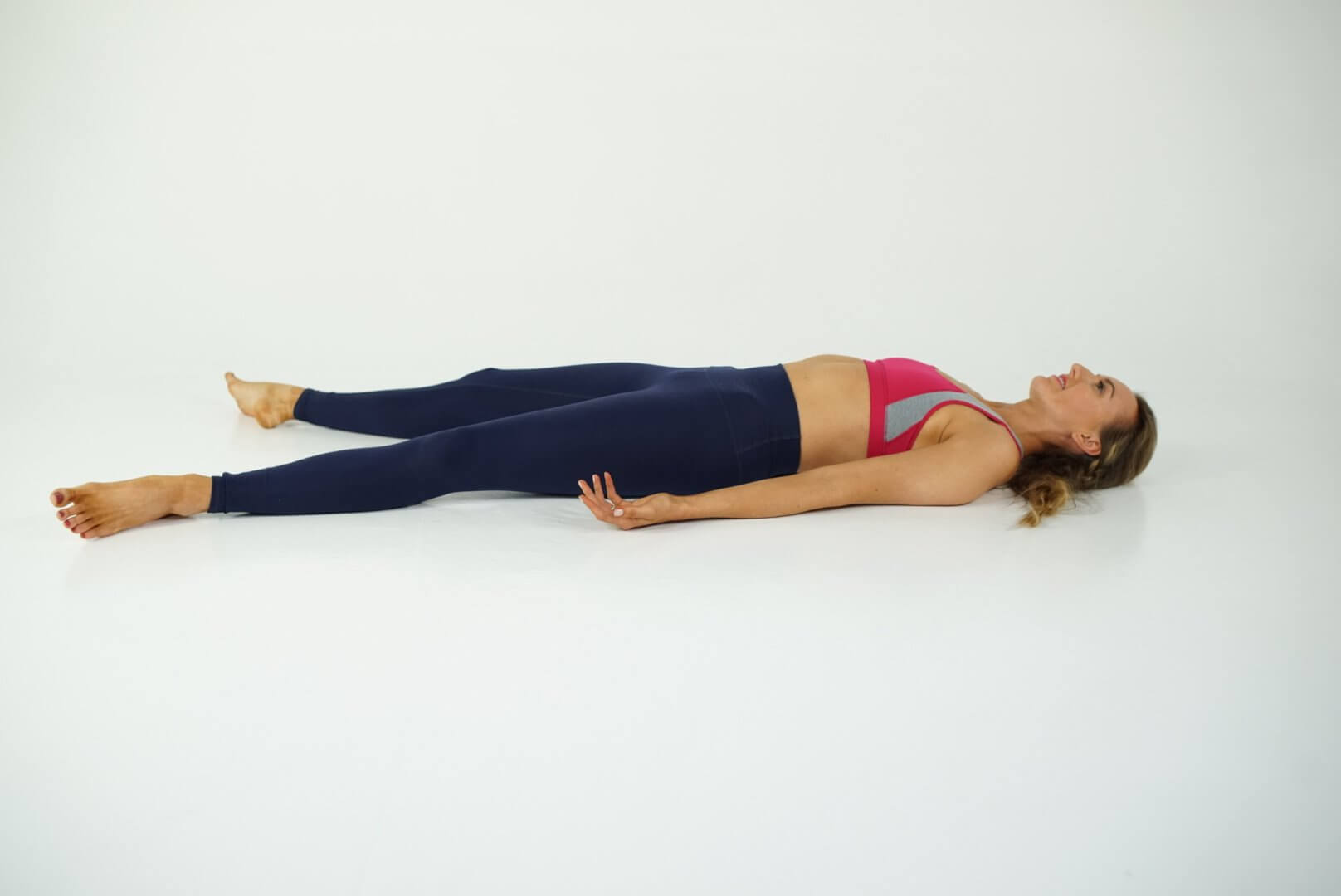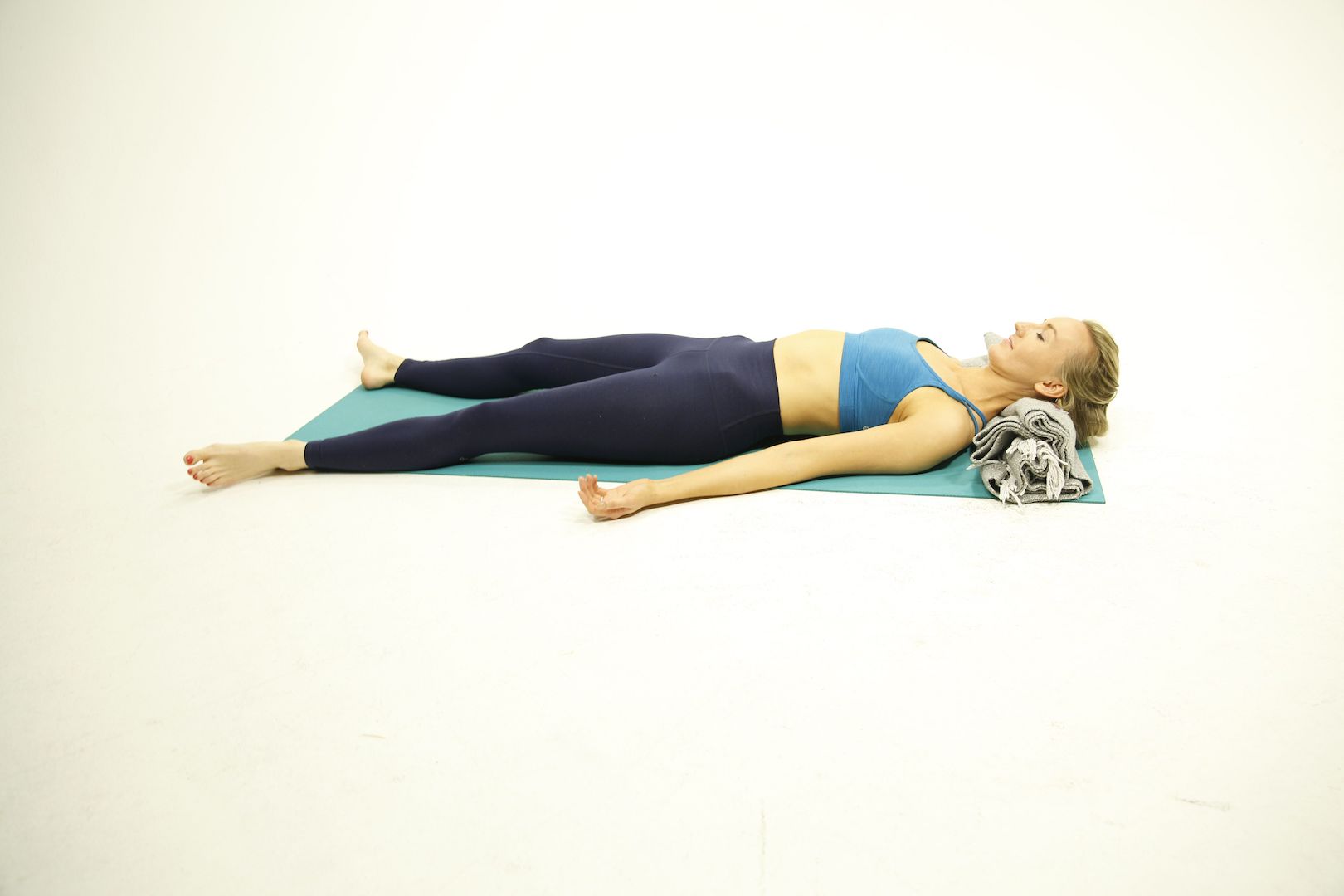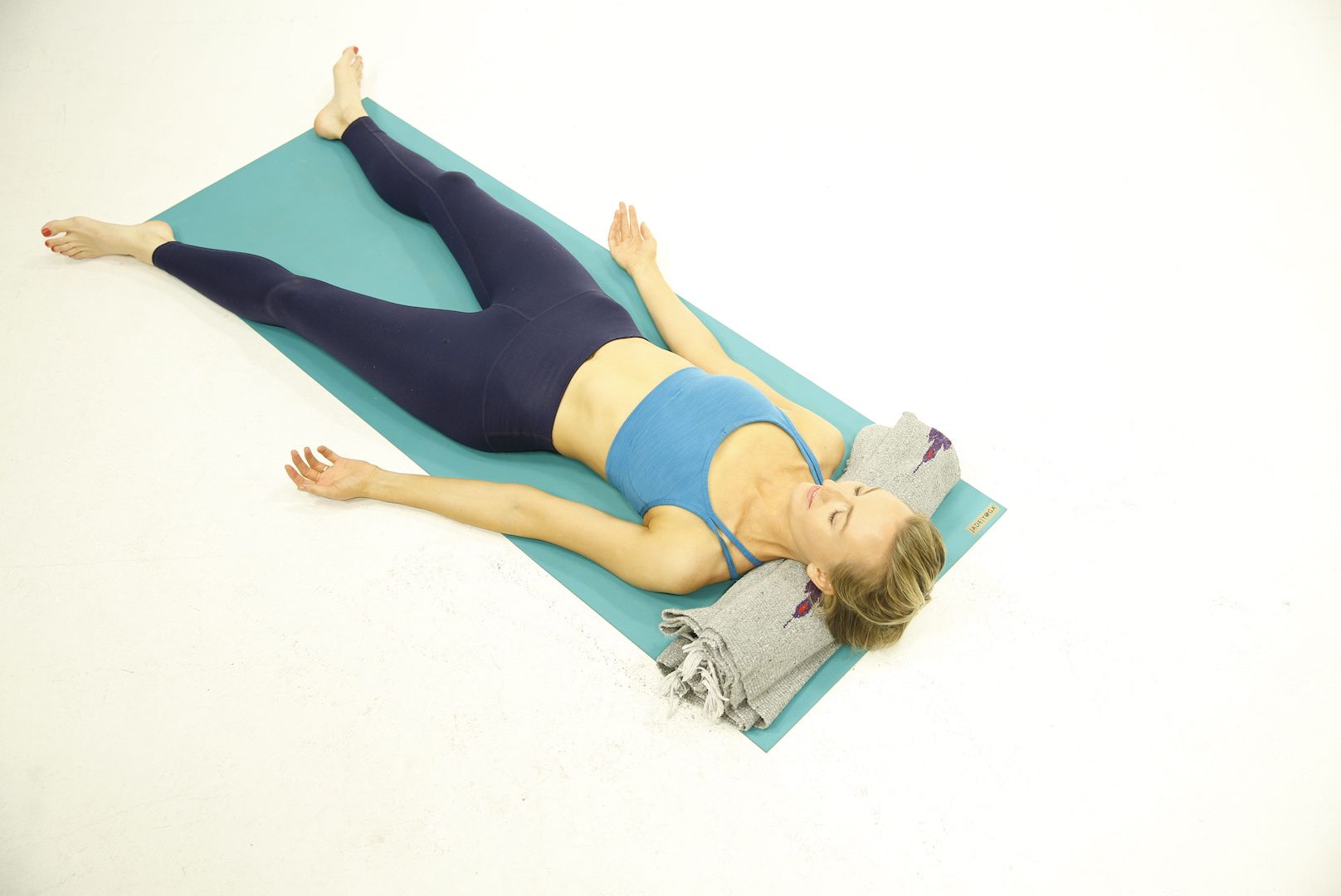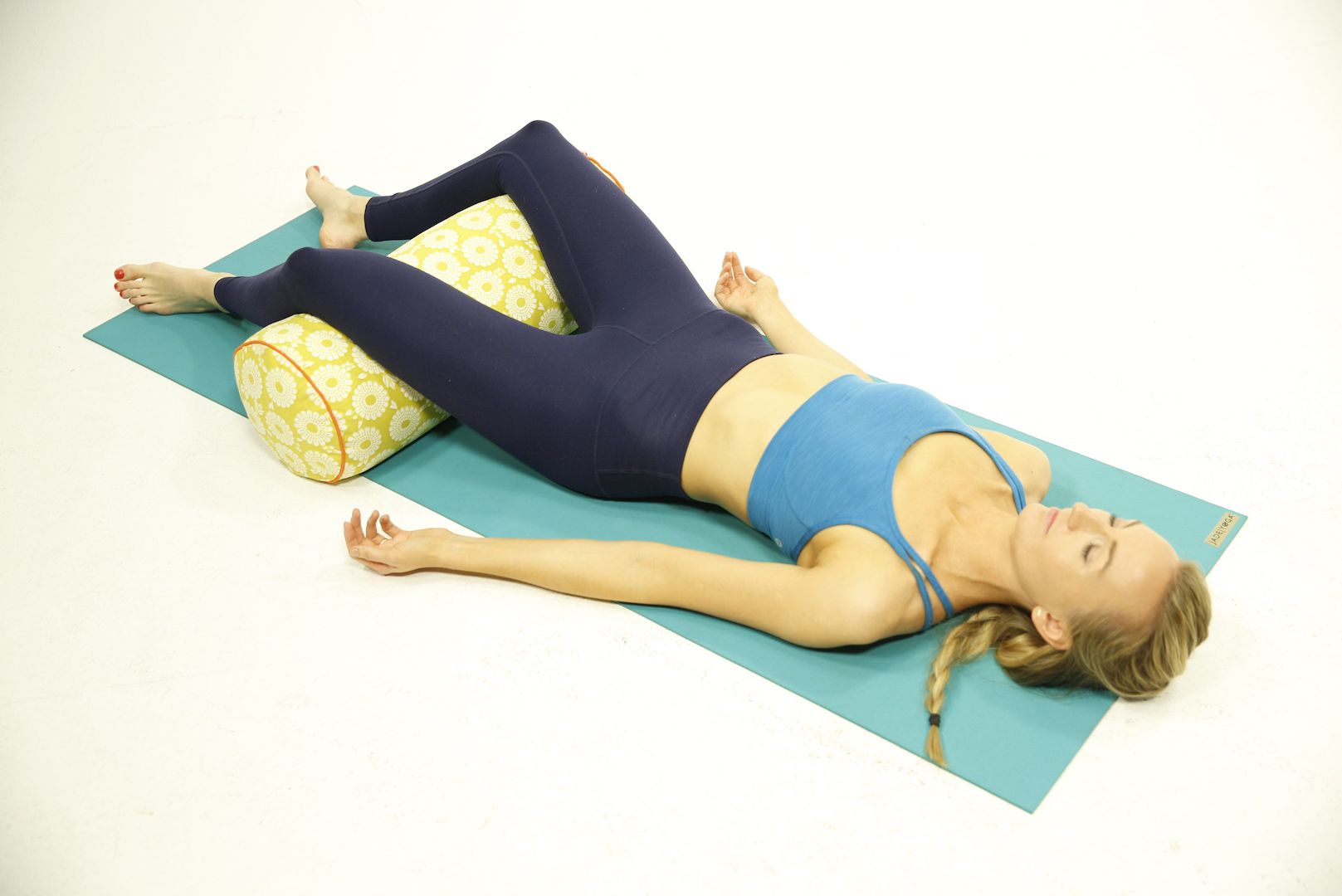(Savasana): Techniques, Benefits, Variations

Corpse Pose Prep & Practice
1
From seated, take both soles of the feet to the mat in front of you.
2
Shift the hips forward and roll down one vertebrae at a time on to your back. Extend one leg out, and then the other to either corner of your mat.
3
Take the arms out to either side of you, palms facing up.
4
Close your eyes, deepen your breath, and relax. Soften through the face. Let your entire body melt into the floor.
5
To come out, begin to wiggle the fingers and toes. Draw one knee into your chest and then the other. Give them a hug.
6
Roll on to your right side and use your left hand to gently press you back up to seated.



Variations/Modifications
- Bring a bolster or rolled up blanket underneath the knees
Physical, Mental and Emotional Benefits
- Allows the major muscle groups to relax
- Encourages introspection
- Calming, stimulates relaxation
- Helps relieve stress
Contraindications
- Pregnancy, lie on your left side instead
- Back Injury
Thoughtful Sequencing
Plank Pose (Phalakasana), Cobra (Bhujangasana), Child’s Pose (Balasana), Bridge (Setu Bandha Sarvangasana), Plow Pose (Halasana), Reclined Hand to Big Toe Pose (Supta Padangusthasana) Left and Right, Reclined Twist (Jathara Parivartanasana) Left and Right, Corpse Pose (Savasana)
Try Corpse Pose On The Blog
A Few Notes
Corpse pose aka Savasana is sometimes seen as the hardest yoga pose of them all. For many yoga students, having the opportunity to lie still, eyes closed, taking time to relax as something as opposed to sleep, sounds like a dream! For some other yoga students, it means having a lot of time for the mind to endlessly race. But as with many other yoga poses, it can take practice to learn the art of relaxation. There are a huge amount of benefits to being still and laying on your back in Savasana.
Firstly, when you close your eyes, you’re shutting off the outside world to allow your body and mind to soften and wind down. The Savasana position isn’t just laying on the floor, although it may look like that!
In Savasana you are releasing the tension in the body, relaxing body part by body part, bringing your whole body into balance.
Begin on the floor, lie on your back with your arms by your side, palms facing upwards to allow for space to externally rotate the shoulder blades. This helps to counteract all of the internal rotation and rounding we do in our everyday lives on our phones/tablets/computers, and it allows your arms and hands to rest and fully relax.
When you rest your head on the floor, lengthen the back of your neck by tucking your chest softly into your chest. With your upper spine in contact with the mat, you can observe your chest gently rising and falling with each breath. In our yoga practice we are trying to control the breath, so here in Savasana, release any control of the breath and allow your breathing pattern to flow naturally. After being led with lots of instructions in a yoga practice, here in Savasana, you’re in control, a bit like in meditation. If thoughts enter the mind, let them come and go like clouds in the sky.
Next, let your legs soften and place your feet hip-width apart with your heels rolling in and toes rolling out. This removes the tension at your hips, it allows your knees to soften so that the muscles around your legs; your hamstrings and quadriceps, can fully rest and feel heavy and rooted to the ground.
Once you’re in your position, take a deep breath in and let it go out of the mouth with a sigh, and feel your whole body relax. Let your breathing flow into a natural rhythm.
Savasana is translated as corpse pose or dead body pose as you are meant to lie there in stillness, not moving, not itching that itch on your arm, not gazing into the distance, just allowing the stillness to do the magic.
Once you start to relax into stillness, your heart rate begins to slow down, especially if you have just done an energizing Vinyasa yoga or Hatha yoga class. Savasana (corpse pose) is usually the final pose of a yoga sequence in yoga classes, and it can be seen as the most important part of your practice.
You’re giving time and space for the breath to slow down, the body to relax on your yoga mat, and allowing your parasympathetic nervous system (the relaxation response) to enter a state of deep relaxation.
If you find that you feel quite restless, lying still with your eyes closed, you may have an overactive sympathetic nervous system (the flight or fight response), so try to take a few deep breaths and keep your awareness on your breath. Whilst some yoga teachers can sometimes offer a guided meditation in Savasana, a different yoga teacher may leave you in stillness. You’ll come to find out which you prefer with each yoga practice.
With regular practice of Savasana, your body and mind will start to reap the long-term health and well-being benefits such as lowering your blood pressure and feeling calmer and centered overall.
A little tip if you are left in silence and feel a bit restless or your mind is going from thought to thought in a yoga class, is to go through a body scan (yoga Nidra meditation). By bringing your awareness to different parts of the body and repeating the name of each part, you’re helping to release tension in the body and it also helps to distract unwanted thoughts.
You can start at the head, forehead, eyes, jaw, neck, chest, shoulder blades, arms, hands, torso, legs, and feet. Then if you’re still fully aware you can scan down the front and back of the body and even the right and left sides of the body.
By resting in savasana pose after your yoga practice, not only is it a resting pose for your entire body, but it can increase your energy levels, help to fix your posture, leaving you feeling rebalanced and ready to go on with your day.
As with all different types of yoga poses, there are modifications in savasana. You don’t just have to lay there on your mat if it’s not comfortable for you! It can feel really nice and cozy to use props in your savasana, especially if you’re planning on staying in corpse pose for longer than a few minutes, like in Yin yoga or Restorative yoga.
You can use blankets to keep warm, place a folded blanket or a few pillows under your head, to support your neck. and also cushions or a bolster under the back of your knees. If you have any lower back issues, having a prop under the back of the knees can help to keep the posture of your spine supported.
Want more yoga pose tutorials? See more in my Yoga Pose Directory.
Learn how to do 11 of the most popular yoga poses correctly. Free video + PDF download.









